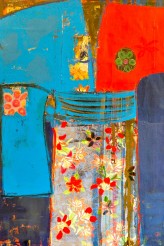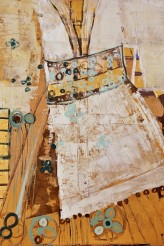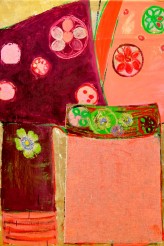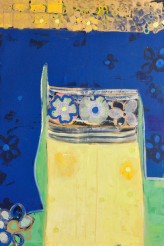As a child, I was baptized by a young Japanese woman who happened to live in the same village as mine. My parents didn’t mind the fact that she was Buddhist while we were Catholic—they simply liked her family, and the feeling was mutual. I remember watching their family perform beautiful tea ceremonies and seeing the girls dressed in extraordinary garments. It was deeply impressive to me, especially considering the very poor area where I was born.
Later, as I became a woman, I often reflected on those days and how the richness of those colors and rituals left a lasting impact on me.
My Kimono paintings are expressions of pride and purpose carried by past generations and offered as a message to the present one. These universal values—respect, beauty, identity—are expressed in local traditions around the globe. Japanese kimonos, much like Chinese hanfu or Vietnamese áo dài, are traditional garments that represent the cultural identity and heritage of their countries.To me, they embody a deep dedication to beauty through exceptional materials such as silk, intricate embroidery, and thoughtful design.
In my work, I aim to capture the cultural heritage they represent and weave it together with Brazilian or other folk fabrics. Through this combination, I hope to show that these traditions transcend borders and time—their message is both timeless and universal.
.
Later, as I became a woman, I often reflected on those days and how the richness of those colors and rituals left a lasting impact on me.
My Kimono paintings are expressions of pride and purpose carried by past generations and offered as a message to the present one. These universal values—respect, beauty, identity—are expressed in local traditions around the globe. Japanese kimonos, much like Chinese hanfu or Vietnamese áo dài, are traditional garments that represent the cultural identity and heritage of their countries.To me, they embody a deep dedication to beauty through exceptional materials such as silk, intricate embroidery, and thoughtful design.
In my work, I aim to capture the cultural heritage they represent and weave it together with Brazilian or other folk fabrics. Through this combination, I hope to show that these traditions transcend borders and time—their message is both timeless and universal.
.





